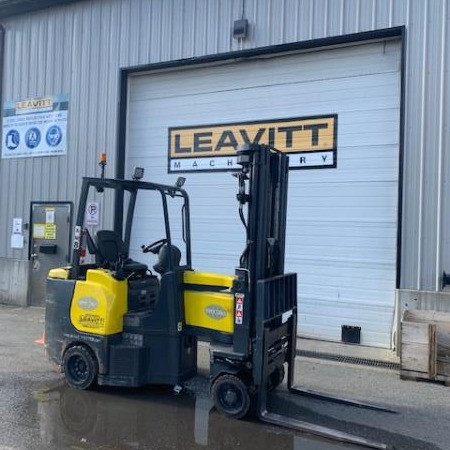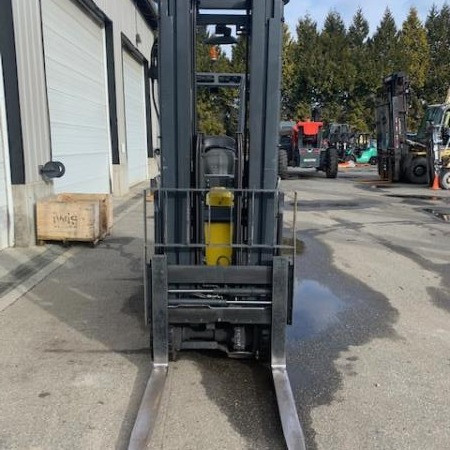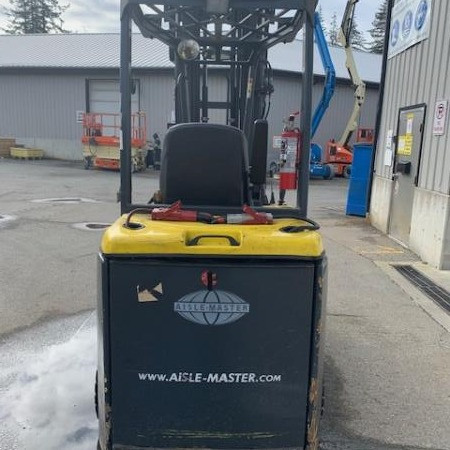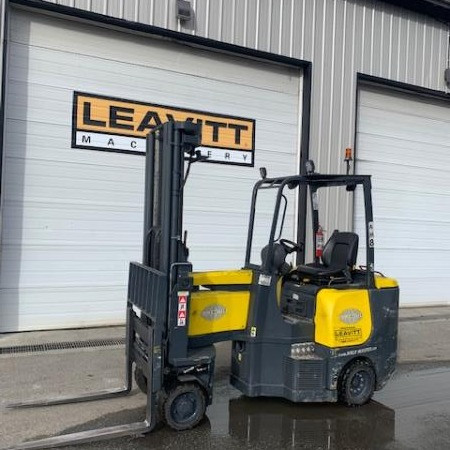Very Narrow Aisle Forklift Murrieta
Used Very Narrow Aisle Forklift Murrieta - Getting items from one warehouse location to another and to and from the loading docks is the focus of warehousing. Focus is often on space saving tools and the layout of the building. Extremely narrow aisles offer more storage space since there is less space needed for aisle access. These warehouse configurations are often referred to as warehouse optimization.
Warehouse Optimization
Several benefits can be enjoyed for adding very narrow aisle warehouse optimization such as more storage space for the facility.
Because very narrow forklift trucks were developed to take up less space in maneuvering, it is now possible to decrease warehouse aisle width to less than half the width required by standard forklifts. Many very narrow aisle forklifts offer greater stack height capability which further increases the storage capacity per square foot. Very narrow aisle forklifts can greatly reduce costs compared to traditional forklifts since the same amount of stock takes up less space in the warehouse. Square footage is costly in urban areas and any way to reduce warehousing costs can save a company money. When planned carefully and properly, it is possible to increase warehouse storage area by up to 80 percent by implementing a very narrow aisle width configuration. Very narrow aisle design facilitates greater product access and more rack faces. This usually equates to less travel time gathering and storing product as more product is located within a smaller, more accessible area.
Very narrow aisle layouts and narrow aisle layouts are popular for warehouses. Narrow aisles are measured as those that use fewer than eleven feet of aisle width. These widths reduce even further to roughly 6.5 feet for very narrow aisles. Both of these aisle widths provide significantly increased storage opportunities. However, they also create challenges when turning within the aisles using forklifts for stocking and order picking. A variety of very narrow forklifts have been designed to easily maneuver in narrow aisles.
It is necessary to know the dimensions of the aisle when selecting a forklift for a certain job. Taking note of the proper dimensions will save valuable time and money by avoiding the mistake of acquiring a forklift that will not work in the intended application. Finally, it is critical that any utilities, posts or columns are taken into account before settling on a specific narrow aisle forklift design as these may affect access to aisles by some forklifts or prevent warehouse optimization.
Very Narrow Aisle Forklift Trucks
As these units are mostly powered by electricity, rechargeable batteries are popular for very narrow aisle forklifts. These very narrow aisle trucks are more commonly available as stand-up riders, which helps increase productivity and operator comfort. There are different very narrow aisle forklift designs such as order pickers, reach trucks, wing-mast or turret and end-control riders.
Reach Forklift Trucks
Reach trucks were designed as a version of the rider stacker forklift but specially modified for use in narrow aisles. It got its name by its function of reaching its forks forward to get to a load. The moving mast and the moving carriage are two types of reach trucks. The moving carriage functions by lowering and raising the carriage and the operator. The moving mast works by raising and lowering the forks along the mast, while the operator stays at ground level. The moving mast reach truck is generally considered the safer of the two types of reach trucks. Reach trucks utilize a pantograph system that is a jointed framework design enabling the driver to place and reach loads without moving the forklift.
Order Pickers
Order pickers have been created to pick items from difficult, high racking systems. They are used for smaller picking items that can be lifted and moved by hand. They lift the operator up to reach the goods by identifying and choosing certain items to create an order.
End-Control Riders
End-control riders can pick up loads along the floor level and transport goods horizontally instead of transporting items over heights.
Turret or Swing-Mast Forklift
Turret or swing-mast very narrow aisle forklift have a pivoting articulating swivel mast. Pallets can be set on either the right or left side of the forklift due to the machine’s ability to use its’ swinging mast.
Guided Very Narrow Aisle Trucks
Very narrow aisle forklift trucks can be guided by rail or wire down the aisles.
Since the forklift truck is guided, the chance of colliding with racks while traversing down the aisles is very low. Rail-guided applications use special rails set into the floor on either side of the aisle, funning the length of the location and curving around the edge. The forklift is fitted with special wheel guides that slide into the rails, preventing the forklift from moving outside the rail guards.
Wire-guidance forklift systems install wires on the floor instead of rails and the wires run down the middle of the aisle. These wire-guides work along the same principle as the rail guards except that the narrow aisle forklift is fitted with a wire-guide system that allows it to communicate with the floor wires which effectively steer the forklift, preventing it from straying outside of an allotted range.
Work Site Considerations
To use a narrow aisle configuration, there are some key considerations that need to be made. The floor and the rack construction needs to be evaluated to avoid any issues since the very narrow aisle units have extremely high racking systems. Four specific areas need to be perfectly prepared before a racking system can be implemented including a level floor, plumb racks, any floor cracks need to be repaired and the floor’s load capacity must be accurate. These locations need to be maintained and monitored continuously.
Level Floor
Because of the height of the racking systems, any slight slope of the floor is likely to negatively affect the plumbness of the racks, especially over time when loads are continuously placed and removed on the racks. A level floor is vital for the safety and integrity of the operator, employees, stock and the warehouse.
Crack Repair
Cracks in the floor ideally should be fixed once they are noticed to ensure everyone’s safety. The level of the floor can become unstable with cracks when they are only 3/8 inches wide. They will need to be filled properly with material as hard as the rest of the floor.
Floor Load Capacity
The floor needs to meet specific minimum requirements prior to a narrow aisle configuration. Minimum flooring requirements include concrete measuring three thousand psi and rebar distributed evenly three to four inches below the surface. Depending on the configuration and load requirements, extra reinforcements may be necessary.
Plumb Racks
Of great importance is the proper installation of the racking system. There is a major chance of rack failure if improper installation occurs. One of the most important details to ensure proper installation, is that all racks are plumb. If necessary, rack shims should be used to ensure the racks are plumb within 1 inch at the 30 foot height of the racks.
Racking failure can happen if the aforementioned measures are not taken or implemented correctly. Employees can become hurt or killed in the event that racking failure occurs. Goods can be damaged along with forklifts and other equipment. Because of these reason, these measures are the most important part of implementing a narrow aisle configuration for warehousing optimization.
Very Narrow Aisle Forklift PDF
Stock Number: 207213 GL
Make: AISLEMASTER
Model: 44E
Year: 2013
| Stock Number |
207213 GL |
| Make |
AISLEMASTER |
| Model |
44E |
| Year |
2013 |
| Category |
Very Narrow Aisle Forklift |
Stock Number: 208758 GL
Make: AISLEMASTER
Model: 44SE
Year: 2015
| Stock Number |
208758 GL |
| Make |
AISLEMASTER |
| Model |
44SE |
| Year |
2015 |
| Category |
Very Narrow Aisle Forklift |
Stock Number: 209213 GL
Make: AISLEMASTER
Model: 44SE
Year: 2015
| Stock Number |
209213 GL |
| Make |
AISLEMASTER |
| Model |
44SE |
| Year |
2015 |
| Category |
Very Narrow Aisle Forklift |













